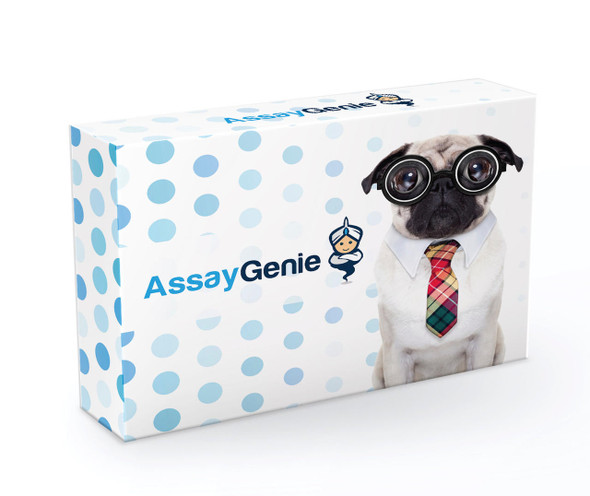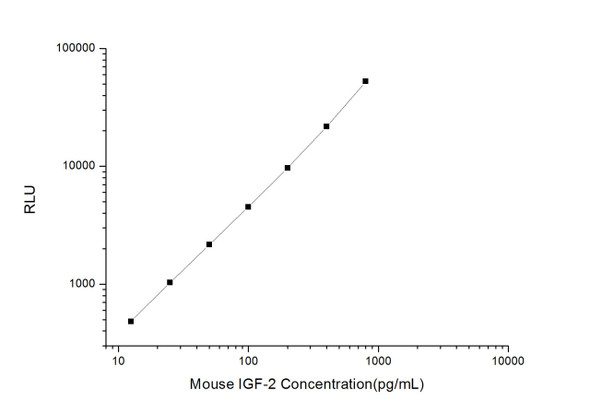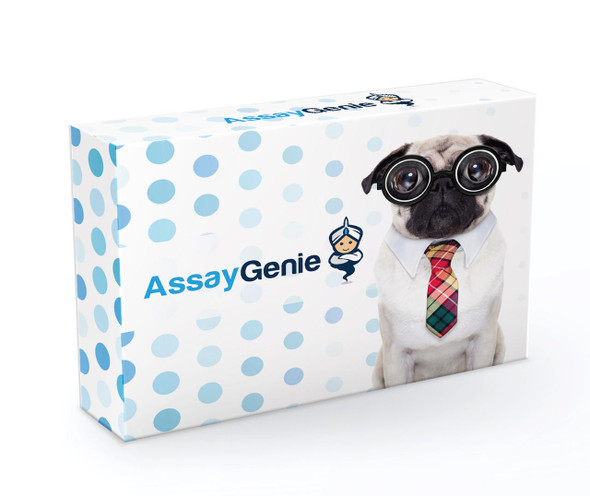Mouse Cell Signalling ELISA Kits 2
Mouse IGF-1 (Insulin-like growth factor 1) CLIA Kit (MOES00031)
- SKU:
- MOES00031
- Product Type:
- ELISA Kit
- ELISA Type:
- CLIA Kit
- Size:
- 96 Assays
- Sensitivity:
- 9.38pg/mL
- Range:
- 15.63-1000pg/mL
- ELISA Type:
- Sandwich
- Synonyms:
- IGF1, IGFI, IGF-I, IGF1A, IGF-IA, IGF-IB, MGF, Somatomedin C
- Reactivity:
- Mouse
- Sample Type:
- Serum, plasma and other biological fluids
Description
| Assay type: | Sandwich |
| Format: | 96T |
| Assay time: | 4.5h |
| Reactivity: | Mouse |
| Detection method: | Chemiluminescence |
| Detection range: | 15.63-1000 pg/mL |
| Sensitivity: | 9.38 pg/mL |
| Sample volume: | 100µL |
| Sample type: | Serum, plasma and other biological fluids |
| Repeatability: | CV < 15% |
| Specificity: | This kit recognizes Mouse IGF-1 in samples. No significant cross-reactivity or interference between Mouse IGF-1 and analogues was observed. |
This kit uses Sandwich-CLIA as the method. The micro CLIA plate provided in this kit has been pre-coated with an antibody specific to Mouse IGF-1. Standards or samples are added to the appropriate micro CLIA plate wells and combined with the specific antibody. Then a biotinylated detection antibody specific for Mouse IGF-1 and Avidin-Horseradish Peroxidase (HRP) conjugate are added to each micro plate well successively and incubated. Free components are washed away. The substrate solution is added to each well. Only those wells that contain Mouse IGF-1, biotinylated detection antibody and Avidin-HRP conjugate will appear fluorescence. The Relative light unit (RLU) value is measured spectrophotometrically by the Chemiluminescence immunoassay analyzer. The RLU value is positively associated with the concentration of Mouse IGF-1. The concentration of Mouse IGF-1 in the samples can be calculated by comparing the RLU of the samples to the standard curve.
| UniProt Protein Function: | IGF1: The insulin-like growth factors, isolated from plasma, are structurally and functionally related to insulin but have a much higher growth-promoting activity. May be a physiological regulator of [1-14C]-2-deoxy-D-glucose (2DG) transport and glycogen synthesis in osteoblasts. Stimulates glucose transport in rat bone-derived osteoblastic (PyMS) cells and is effective at much lower concentrations than insulin, not only regarding glycogen and DNA synthesis but also with regard to enhancing glucose uptake. Defects in IGF1 are the cause of insulin-like growth factor I deficiency (IGF1 deficiency). IGF1 deficiency is an autosomal recessive disorder characterized by growth retardation, sensorineural deafness and mental retardation. Belongs to the insulin family. 3 isoforms of the human protein are produced by alternative splicing. |
| UniProt Protein Details: | Protein type:Secreted; Motility/polarity/chemotaxis; Secreted, signal peptide Cellular Component: extracellular space; cell soma; extracellular region; intracellular Molecular Function:integrin binding; protein serine/threonine kinase activator activity; insulin-like growth factor receptor binding; protein binding; growth factor activity; hormone activity; steroid binding; insulin receptor binding Biological Process: positive regulation of transcription, DNA-dependent; regulation of protein metabolic process; chondroitin sulfate proteoglycan biosynthetic process; exocrine pancreas development; water homeostasis; positive regulation of glucose import; positive regulation of fibroblast proliferation; proteoglycan biosynthetic process; inner ear development; positive regulation of DNA binding; muscle hypertrophy; nervous system development; positive regulation of mitosis; positive regulation of protein import into nucleus, translocation; regulation of establishment and/or maintenance of cell polarity; regulation of calcium ion transport; positive regulation of cell growth; positive regulation of phosphoinositide 3-kinase cascade; cell activation; positive regulation of peptidyl-tyrosine phosphorylation; insulin-like growth factor receptor signaling pathway; branching morphogenesis of a tube; response to heat; regulation of gene expression; positive regulation of fat cell differentiation; positive regulation of transcription from RNA polymerase II promoter; alveolus development; positive regulation of epithelial cell proliferation; negative regulation of apoptosis; positive regulation of insulin-like growth factor receptor signaling pathway; positive regulation of smooth muscle cell proliferation; myoblast proliferation; positive regulation of glycogen biosynthetic process; negative regulation of caspase activity; detection of mechanical stimulus involved in sensory perception; positive regulation of activated T cell proliferation; positive regulation of smooth muscle cell migration; regulation of translation; negative regulation of cell proliferation; glial cell differentiation; positive regulation of MAPKKK cascade; mammary gland development; positive regulation of cell proliferation; regulation of steroid hormone receptor signaling pathway; positive regulation of granule cell precursor proliferation; regulation of protein amino acid phosphorylation; phosphoinositide-mediated signaling; multicellular organism growth; myotube cell development; satellite cell compartment self-renewal involved in skeletal muscle regeneration; memory; regulation of cell proliferation; myoblast differentiation; cell proliferation; positive regulation of protein kinase B signaling cascade; positive regulation of osteoblast differentiation; positive regulation of tyrosine phosphorylation of Stat5 protein; positive regulation of glycolysis; blood vessel remodeling; positive regulation of Ras protein signal transduction; cell development; positive regulation of DNA replication; lung development |
| UniProt Code: | P05017 |
| NCBI GenInfo Identifier: | 56405309 |
| NCBI Gene ID: | 16000 |
| NCBI Accession: | P05017. 2 |
| UniProt Secondary Accession: | P05017,P05018, Q6LDP4, Q8C4U6, |
| UniProt Related Accession: | P05017 |
| Molecular Weight: | 17,623 Da |
| NCBI Full Name: | Insulin-like growth factor I |
| NCBI Synonym Full Names: | insulin-like growth factor 1 |
| NCBI Official Symbol: | Igf1 |
| NCBI Official Synonym Symbols: | Igf-1; Igf-I; C730016P09Rik |
| NCBI Protein Information: | insulin-like growth factor I; somatomedin |
| UniProt Protein Name: | Insulin-like growth factor I |
| UniProt Synonym Protein Names: | Somatomedin |
| UniProt Gene Name: | Igf1 |
| UniProt Entry Name: | IGF1_MOUSE |
As the RLU values of the standard curve may vary according to the conditions of the actual assay performance (e. g. operator, pipetting technique, washing technique or temperature effects), the operator should establish a standard curve for each test. Typical standard curve and data is provided below for reference only.
| Concentration (pg/mL) | RLU | Average | Corrected |
| 1000 | 52510 54840 | 53675 | 53650 |
| 500 | 22311 22667 | 22489 | 22464 |
| 250 | 10624 9798 | 10211 | 10186 |
| 125 | 4545 5257 | 4901 | 4876 |
| 62.5 | 2479 2427 | 2453 | 2428 |
| 31.25 | 1350 1212 | 1281 | 1256 |
| 15.63 | 679 737 | 708 | 683 |
| 0 | 24 26 | 25 | -- |
Precision
Intra-assay Precision (Precision within an assay): 3 samples with low, mid range and high level Mouse IGF-1 were tested 20 times on one plate, respectively.
Inter-assay Precision (Precision between assays): 3 samples with low, mid range and high level Mouse IGF-1 were tested on 3 different plates, 20 replicates in each plate.
| Intra-assay Precision | Inter-assay Precision | |||||
| Sample | 1 | 2 | 3 | 1 | 2 | 3 |
| n | 20 | 20 | 20 | 20 | 20 | 20 |
| Mean (pg/mL) | 54.43 | 119.15 | 356.50 | 49.44 | 111.09 | 360.41 |
| Standard deviation | 5.08 | 10.07 | 23.92 | 5.91 | 8.53 | 33.70 |
| C V (%) | 9.33 | 8.45 | 6.71 | 11.95 | 7.68 | 9.35 |
Recovery
The recovery of Mouse IGF-1 spiked at three different levels in samples throughout the range of the assay was evaluated in various matrices.
| Sample Type | Range (%) | Average Recovery (%) |
| Serum (n=5) | 89-102 | 94 |
| EDTA plasma (n=5) | 92-106 | 97 |
| Cell culture media (n=5) | 91-109 | 99 |
Linearity
Samples were spiked with high concentrations of Mouse IGF-1 and diluted with Reference Standard & Sample Diluent to produce samples with values within the range of the assay.
| Serum (n=5) | EDTA plasma (n=5) | Cell culture media (n=5) | ||
| 1:2 | Range (%) | 95-108 | 94-106 | 90-105 |
| Average (%) | 100 | 101 | 96 | |
| 1:4 | Range (%) | 97-112 | 85-98 | 96-112 |
| Average (%) | 104 | 92 | 102 | |
| 1:8 | Range (%) | 100-115 | 92-103 | 92-105 |
| Average (%) | 108 | 97 | 99 | |
| 1:16 | Range (%) | 89-102 | 102-116 | 87-100 |
| Average (%) | 96 | 110 | 92 |
An unopened kit can be stored at 4°C for 1 month. If the kit is not used within 1 month, store the items separately according to the following conditions once the kit is received.
| Item | Specifications | Storage |
| Micro CLIA Plate(Dismountable) | 8 wells ×12 strips | -20°C, 6 months |
| Reference Standard | 2 vials | |
| Concentrated Biotinylated Detection Ab (100×) | 1 vial, 120 µL | |
| Concentrated HRP Conjugate (100×) | 1 vial, 120 µL | -20°C(shading light), 6 months |
| Reference Standard & Sample Diluent | 1 vial, 20 mL | 4°C, 6 months |
| Biotinylated Detection Ab Diluent | 1 vial, 14 mL | |
| HRP Conjugate Diluent | 1 vial, 14 mL | |
| Concentrated Wash Buffer (25×) | 1 vial, 30 mL | |
| Substrate Reagent A | 1 vial, 5 mL | 4°C (shading light) |
| Substrate Reagent B | 1 vial, 5 mL | 4°C (shading light) |
| Plate Sealer | 5 pieces | |
| Product Description | 1 copy | |
| Certificate of Analysis | 1 copy |
- Set standard, test sample and control (zero) wells on the pre-coated plate and record theirpositions. It is recommended to measure each standard and sample in duplicate. Note: addall solutions to the bottom of the plate wells while avoiding contact with the well walls. Ensuresolutions do not foam when adding to the wells.
- Aliquot 100µl of standard solutions into the standard wells.
- Add 100µl of Sample / Standard dilution buffer into the control (zero) well.
- Add 100µl of properly diluted sample (serum, plasma, tissue homogenates and otherbiological fluids. ) into test sample wells.
- Cover the plate with the sealer provided in the kit and incubate for 90 min at 37°C.
- Aspirate the liquid from each well, do not wash. Immediately add 100µL of BiotinylatedDetection Ab working solution to each well. Cover the plate with a plate seal and gently mix. Incubate for 1 hour at 37°C.
- Aspirate or decant the solution from the plate and add 350µL of wash buffer to each welland incubate for 1-2 minutes at room temperature. Aspirate the solution from each well andclap the plate on absorbent filter paper to dry. Repeat this process 3 times. Note: a microplatewasher can be used in this step and other wash steps.
- Add 100µL of HRP Conjugate working solution to each well. Cover with a plate seal andincubate for 30 min at 37°C.
- Aspirate or decant the solution from each well. Repeat the wash process for five times asconducted in step 7.
- Add 100µL of Substrate mixture solution to each well. Cover with a new plate seal andincubate for no more than 5 min at 37°C. Protect the plate from light.
- Determine the RLU value of each well immediately.






